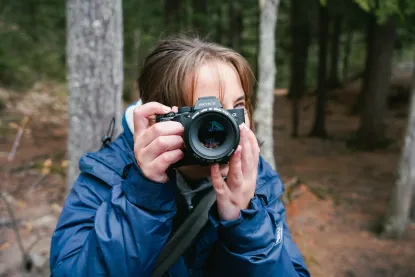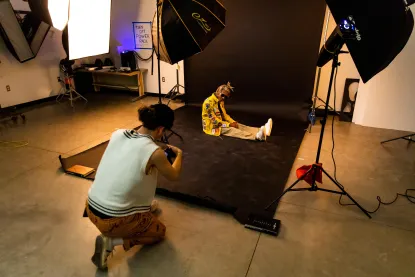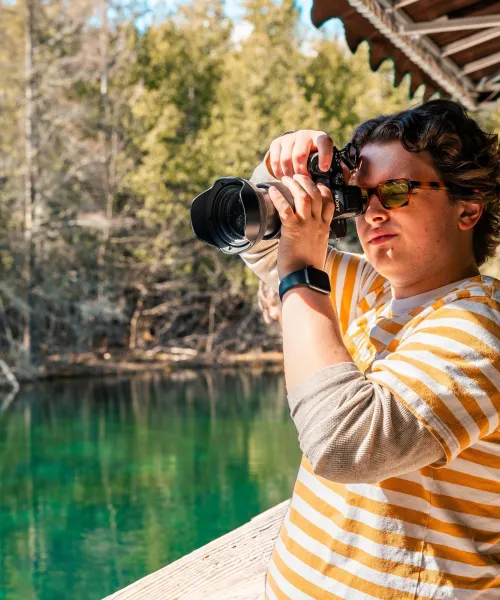Quick Links

About the Program
The Photography Program at Northern Michigan University provides students with a strong foundation in technical expertise, creative exploration, and conceptual development, preparing them for success in the diverse and evolving field of photography.
Our curriculum is designed to support students at all levels, from building essential technical skills in digital and analog photography to developing a personal artistic voice through advanced coursework. Introductory classes emphasize camera operation, professional printing, studio lighting, analog practices, and post-processing techniques using industry-standard software such as Adobe Lightroom and Photoshop. As students progress, upper-level courses focus on using photography as a tool for visual communication, encouraging personal expression and research, experimentation, and portfolio development tailored to each individual student’s career goals.
Photography Faculty
Christine Lenzen
Professor
clenzen@nmu.edu
906-227-2162
Nathan Bett
Contingent Assistant Professor
nabett@nmu.edu
906-227-2223
Photography Courses
ARTD 217 Photography: Foundations
4 credit hours
Offered: Fall, Winter
Introduction to the technical and compositional aspects of digital photography. Through creative assignments, students are encouraged to explore and develop their unique strengths and interests within the medium.
AD 317A Photography: Analog Methods
4 credit hours
Offered: Fall
Prerequisite: AD 212 or AD 217 or instructor permission.
Introduction to analog photography processes. Through creative projects, students are encouraged to explore the various qualities of analog techniques while continuing to advance their individual photographic practices.
AD 317B Photography: Digital Methods
4 credit hours
Offered: Fall, Winter
Prerequisite: AD 212 or AD 217 or instructor permission.
Students expand their knowledge of digital photography, focusing on advanced digital techniques and creative processes while developing their individual photographic practices.
AD 417A Photography: Contemporary Practices
4 credit hours
Offered: Winter, odd-numbered years
Prerequisite: AD 303 or concurrent enrollment, AD 317A or AD317B or instructor’s permission.
Design and implementation of individual advanced projects while exploring contemporary theoretical and critical photographic concepts.
AD 417B Photography: Professional Practices
4 credit hours
Offered: Winter, even-numbered years
Prerequisite: AD 303 or concurrent enrollment, AD 317A or AD317B or instructor’s permission.
Design and implementation of individual advanced projects while gaining knowledge of professional practices within the photographic field.

Hands-On Learning & Facilities
We believe that hands-on experience is essential for mastering photography. Our state-of-the-art facilities provide students with the tools to work in both digital and traditional photographic methods:
- Professional Lighting Studios – Designed to match the standards of a professional photography studio, our lighting space is fully equipped with high-powered strobes, a variety of light modifiers, and other essential equipment. Whether students are mastering portrait lighting, experimenting with creative setups, or working on commercial projects, the studio provides the tools and flexibility needed to produce professional-quality images.
- Darkroom & Alternative Processes Lab – In an era dominated by digital imagery, NMU offers students the opportunity to explore the magic of traditional and historic photographic techniques. Our fully equipped darkroom supports black-and-white film development and printing, while our alternative processes lab allows students to experiment with 19th-century printing methods such as cyanotype, platinum/palladium, gum bichromate, and van dyke brown. By blending digital negatives with hand-crafted techniques, students gain a deeper understanding of photography’s rich history while pushing creative boundaries in contemporary image-making.
- Digital Labs – Our digital labs provide the tools for students to bring their creative visions to life. Equipped with industry-standard software and professional printing capabilities, these spaces allow for seamless digital workflow from advanced image editing to large-format fine art printing. Whether perfecting color accuracy, crafting exhibition-ready prints, or experimenting with new techniques, students have access to the technology needed to push their work to the next level.
- Equipment Checkout – Students have access to a robust collection of professional gear, ensuring they’re always ready to capture their next great image. From high-quality digital and film cameras to professional lenses, lighting equipment, and portable strobes, our lending service allows students to experiment with new tools and techniques without the burden of personal equipment costs. Whether shooting in the studio or on location, NMU photographers have the resources to turn their creative ideas into reality.
Students also have the opportunity to integrate their photography studies with related disciplines such as Graphic Design and Digital Cinema, broadening their creative skill set.
Photography FAQ
What kind of equipment do I need in order to take a photography course?
Students in the photography classes have access to an extensive Equipment Checkout stocked with professional gear. This includes high-quality digital cameras, lenses, tripods, lighting equipment, portable strobes, and more. Whether working in the studio or on location, students can experiment with a wide range of tools and techniques without needing to own their own equipment.
Some students do choose to use a personal camera, and we’re happy to offer guidance. Our program teaches on Canon’s mirrorless system, and the Canon R100 is the recommended introductory model for students with the Canon R8 as an excellent upgrade option with full-frame sensors and higher image quality. Whichever route you take, we strongly recommend selecting a mirrorless camera as this is the direction the entire industry has moved, and it is the system students will learn on in their courses.
Note: While other brands also make excellent cameras that can be used for coursework, Canon is the standard across the School of Art & Design, which ensures consistency in teaching, support, and compatibility with lenses and accessories available through the Equipment Checkout.
What will I study in the photography program?
Students begin with foundational skills and progress toward advanced creative and conceptual development. Coursework includes:
- Foundations of Photography:
Camera operation, exposure, composition, and post-processing using industry standard programs like Adobe Lightroom. - Intermediate Techniques:
Studio lighting, film photography, analog printing (including both traditional darkroom methods and alternative processes such as cyanotype), advanced digital editing, and high-production digital workflows that emphasize efficient shooting, file management, and consistent output for professional contexts. - Upper-Level Practice:
Using photography as a tool for visual communication through research-driven projects, experimentation, personal expression, and the development of a professional portfolio tailored to individual goals.
What career paths are available to photography graduates?
Photography graduates pursue a wide range of creative and professional careers, and the program is designed to support multiple pathways. Students build a strong foundation in digital imaging, studio lighting, and visual communication, while upper-level courses allow them to deepen their interests—whether in commercial photography, fine art, interdisciplinary work, or preparation for graduate study.
NMU Photography graduates have found work across many photographic disciplines, including:
- Portrait, lifestyle, and wedding photography
- Commercial, editorial, and fashion work
- Food, product, and advertising photography
- Photojournalism and documentary work
- Fine art, exhibition, and gallery practice
NMU Alumni have established careers throughout the Midwest and beyond, with some moving into creative hubs such as Los Angeles, New York, and Chicago. Others have continued their education in MFA programs, further developing their artistic practice or preparing for careers in higher education.
Are there scholarships available for incoming first-year students?
For information about scholarships for incoming freshmen, please visit the Scholarships & Financial Aid page.
